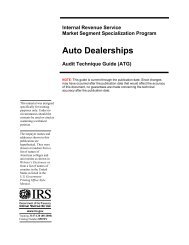Publication 963 (Rev. October 1997) - Uncle Fed's Tax*Board
Publication 963 (Rev. October 1997) - Uncle Fed's Tax*Board
Publication 963 (Rev. October 1997) - Uncle Fed's Tax*Board
Create successful ePaper yourself
Turn your PDF publications into a flip-book with our unique Google optimized e-Paper software.
Determining Worker Status<br />
NOTES<br />
Behavorial Control<br />
Included under this category are facts that show whether the government entity has a right<br />
to direct and control how the worker performs the specific task for which he or she is engaged.<br />
This includes evaluation of the following issues.<br />
Instructions<br />
Instructions the government entity gives the worker must be evaluated. An employee is<br />
generally subject to the government entity’s instructions about when, where, and how to<br />
work. Even if no instructions are given, sufficient behavioral control may exist if the<br />
employer has the right to control how the work results are achieved.<br />
Virtually ever government entity will impose on workers, whether independent contractors<br />
or employees, some form of instruction (for example, requiring that the job be performed<br />
within specified time frames). This fact alone is not sufficient evidence to determine the<br />
worker’s status.<br />
As with every relevant fact, the goal is to determine whether the government entity has<br />
retained the right to control the details of a worker’s performance or instead has given up its<br />
right to control these details. Accordingly, the weight of “instructions” in any case depends<br />
on the degree to which instructions apply to how the job gets done rather than to the end<br />
result.<br />
Instructions about how to do the work may cover a wide range of topics, for example:<br />
♦ when to do the work<br />
♦ where to do the work<br />
♦ what tools or equipment to use<br />
♦ what workers to hire to assist with the work<br />
♦ where to purchase supplies or services<br />
♦ what work must be performed by a specified individual (including ability to hire<br />
assistants)<br />
♦<br />
♦<br />
what routines or patterns must be used.<br />
what order or sequence to follow.<br />
The requirement that a worker obtain prior approval before taking certain actions is an<br />
example of instructions.<br />
Degree of Instruction<br />
The degree of instruction depends on the scope of instructions, the extent to which the<br />
government entity retains the right to control the worker’s compliance with the instructions,<br />
and the effect on the worker in the event of noncompliance. All these provide useful clues<br />
for identifying whether the government entity keeps control over the manner and means of<br />
work performance (leaning toward employee status), or only over a particular product or<br />
service (leaning toward independent contractor status).<br />
The more detailed the instructions are that the worker is required to follow, the more<br />
control the government entity exercises over the worker, and the more likely the government<br />
entity retains the right to control the methods by which the worker performs the work.<br />
Absence of detail in instructions reflects less control.<br />
3-12 Federal-State Reference Guide (<strong>1997</strong> Edition)
















